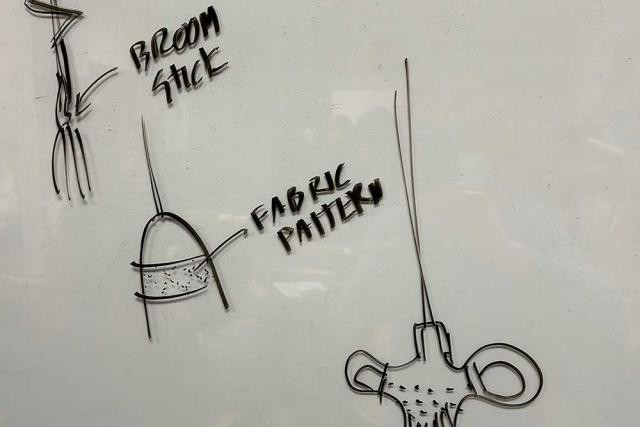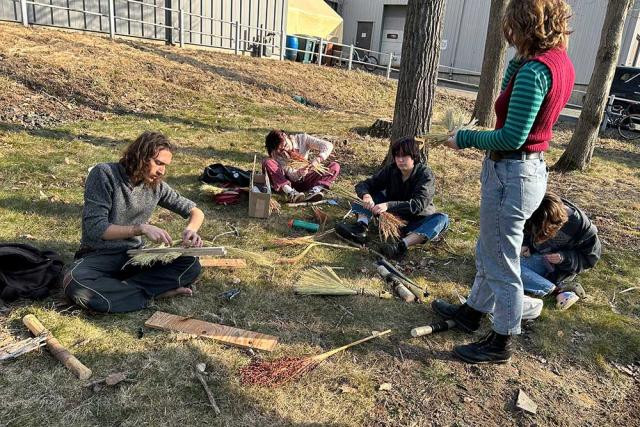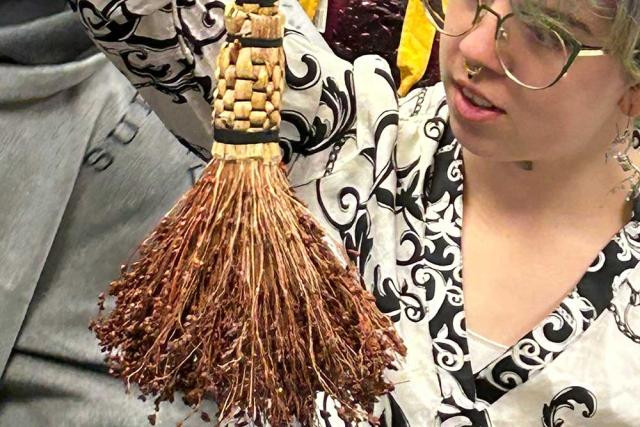Student Co-teaches Interdisciplinary Class in Environments and Change Learning Collaborative

This spring, Associate Professor of Applied Design Donna Cohn and Div II student Luka Eriksen S23 partnered to offer the class Making Brooms: The Circular Economy Versus the Material Economy, which weaves together an array of related topics.
Luka, who is a transfer student, is a trained practitioner of the broom-making craft, having learned the techniques while studying at Berea College, in Kentucky, “whereas,” Cohn says, “I know how to run a class.” Lest she sell herself short, she is also an expert in design, keen on utilizing low-cost tools and materials, collaborating with end-users, and solving practical problems with a focus on ecological sustainability.
The Environments and Change Learning Collaborative explores ways to address the challenge of creating a just future in the face of climate change while living a sustainable life. The interdisciplinary broom-making class incorporates environmental themes along with design and economics.
“Teaching broom craft is something I’ve been excited about ever since my time at Berea,” says Luka. “At Hampshire, I saw a unique opportunity to engage with this craft in a more expanded conceptual form, exploring history, ecology, sculpture, and various ideas about land stewardship and our human relationship with the world around us.”
Cohn and Eriksen grew the broom corn for the class at the Hampshire Farm last summer and harvested it in October. With their students, they foraged the Hampshire woods for vines and grasses to incorporate into the brooms. Students gathered branches, sedges, and other plant materials from various spots on campus. The class read about and discussed the culture, history, and entrepreneurial practice of broom-making in nearby Hadley in the 1800s. They studied and practiced the techniques required to create them, surprised by the difficulty in making these functional and aesthetic tools. But the outcomes were visually stunning, and the students were happy with their results.
Through the process they learned the meaning and value of making things by hand using renewable materials and practices that aren’t detrimental to the environment, contrasted by looking at the high-volume manufacturing of inexpensive brooms.
Recent alum Max Cheney 13F visited the class to discuss his family’s brush-making business and what it takes to compete in today’s global economy. Cheney donated tufts of horse and boar hair, the plant fibers tampico, palmyra, and bassine, and brightly colored nylon and polypropylene for the students to experiment with.
For their final project, each student will design and create an object using broom- and brush-making techniques to sell, barter, or give as a gift. (A request from the Hampshire Farm was a scratching brush for the cows!)
“This class came together with effort but no great hurdles, as there might be at a more traditional college,” says Cohn. “I didn’t have to convince anyone that this was a good idea —everyone could see that it would be satisfying for students to work with their hands and be able to put that work in some larger context.”
“In my sculptural broom work, I like to challenge the domesticity and utility of the broom as an object, and, more generally, to affirm the autotelic worth of beautiful things,” Luka says. “Despite this, I find that everything I create still holds lingering connotations of usability that I can’t quite shake. Going into the semester, I was especially curious to see what kind of broom work would materialize in this much looser and freer environment, where there was no pressure to create sellable or marketable objects. Though most people’s brooms have been largely for the function of sweeping or brushing, I noticed a lot of technical invention and playfulness, which I found inspiring.
“Donna and I are in talks to run this class for a second time during my Div III,” he says. “I think it would be a great opportunity to really refine this class, and be able to apply everything we’ve learned this time around to offer something even fuller and more rewarding in the future.”
Luka Eriksen is also a sculptor and jewelry maker. Watch a video about his work here.















